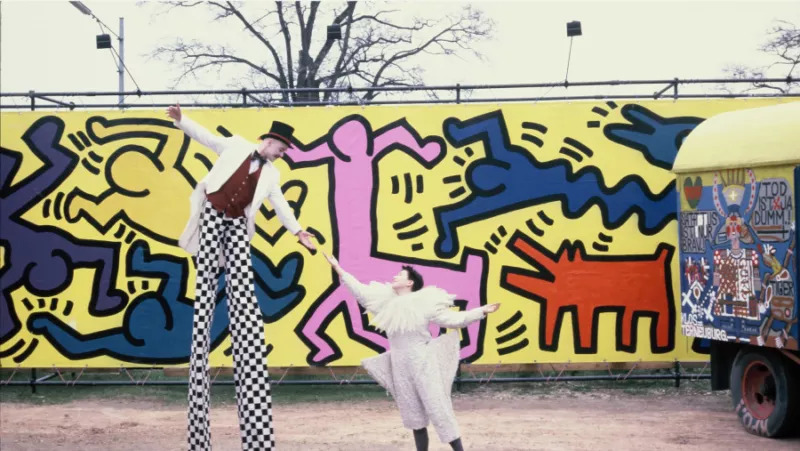Jean Michel Basquiat passed away in 1988, Salvador Dalí in 1989, and Keith Haring in 1990. In 1987, just before bidding farewell to the world, these three icons collaborated on a project that now stands as a whimsical, sublime, and absurd epitome of 20th-century art: Luna Luna, an amusement park crafted with pieces designed by these artists that opened in Hamburg during the summer of that year. It enjoyed popularity for a single season, before its attractions ended up abandoned in containers in a Texas town called Nocona, fading from memory for 35 years. However, before Christmas, Luna Luna is set to reopen its doors in Los Angeles, fueled by a $100 million investment from Canadian rapper Drake.
In its past life, Luna Luna borrowed its name from the old Luna Parks, the early 20th-century amusement parks. In reality, it was more a collection of fairground attractions than a conventional theme park. In 2023, it will reopen primarily as a grand art installation rather than anything else: most of the original 1987 pieces don't meet current safety standards, nor do they offer the thrills contemporary park-goers expect. But its history is unlike any other.
André Heller, an Austrian poet, avant-garde musician, and performance artist (born in 1947), conceived the idea in 1987 to curate an art exhibition resembling a summer fair. Heller, in the book/catalog of the original Luna Luna, shared that his fondest childhood memories were of the Prater, Vienna's amusement park, which had been spared from the destruction and misery of the post-war period. Thus, his intention in creating Luna Luna wasn't to satirize entertainment culture, unlike many 20th-century artists, but to recreate the childhood fascination of stepping into an amusement park for the first time.
Heller received half a million dollars at that time from a donor for funding, turned down a sponsorship offer from McDonald's, and signed up 30 artists at an equal rate of $10,000 per piece. This fee was considerably low considering the cachet of many participants: Roy Lichtenstein, David Hockney, Georg Baselitz, Kenny Scharf, Jean Tiguely, and Sonia Delaunay were among those involved, while Philip Glass and Miles Davis composed music for its passages. Heller mentioned that the artists agreed to work for little money because the project appealed to them all.
Dalí crafted a house of mirrors; Basquiat took charge of the Ferris wheel; Lichtenstein, the maze; Haring, the carousel... There was even an attraction dedicated to Andy Warhol (who passed away in 1987 before completing his piece for Luna Luna), allowing visitors to take photos alongside representations of Einstein, Marilyn, and Marlene Dietrich — living like celebrities for 15 minutes.
Luna Luna operated in June, July, and August of 1987, situated in Moorweide, a relatively central meadow in Hamburg, next to its largest lake. Tickets cost 20 Marks and 240,000 people passed through the gates. If the photographs from that German summer are anything to go by, Luna Luna's audience was more family-oriented than artistic. There is a portrait of Basquiat with a group of euphoric children that leads one to believe that the project fulfilled its initial purpose.
Consequently, two years later, the installation reappeared in San Diego, California, as a donation to a foundation. Before its opening, a legal conflict arose over contract breaches, leading Luna Luna's pieces to end up sealed in trailers, never to be seen again.
It all sounds very Paul Auster, doesn't it? Since 2017, professionals and academics have resurrected the Luna Luna story and pondered the possibility of salvaging its treasures. In 2019, Michael Goldberg, a Los Angeles publicist, stumbled upon Luna Luna's tale and made it his obsession during the pandemic. Goldberg caught the attention of Dreamcrew, a production company founded by Drake in 2017, responsible for, among other products, the hit TV series Euphoria. Dreamcrew purchased Luna Luna's old remnants, restored them, and reintroduced them to the world in an exhibition curated by Helen Molesworth.
What's Drake's role in this story, then? Like fellow artists Kanye West, Jay Z, and A$AP Rocky, the Canadian musician has been involved in contemporary art circles for at least a decade. What is Euphoria if not the TV series with the most references to Pre-Raphaelite painting, body art and video art that has ever reached the mainstream? In 2015, Drake served as an inspirer/curator for an exhibition of African American artists at Sotheby's and has often expressed his fascination with James Turrell, a land art artist from the same generation as André Heller. Drake also exhibits a piano modified by Takashi Murakami in his Toronto home, alongside artworks echoing the history of pop music. He frequently presents himself as a performative character. Art seems to be a means of dignifying and expanding his own body of work.
